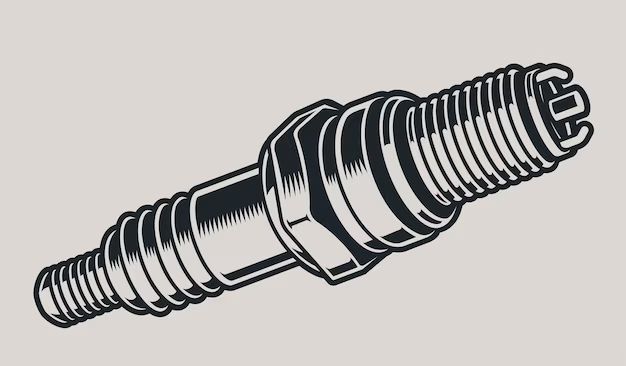When using a spark plug tester, also known as a spark tester or ignition tester, the meaning of the light can indicate different things about the health and performance of your engine’s ignition system. Understanding what the spark plug tester light means is important for diagnosing and resolving ignition issues.
Page Contents
How Does a Spark Plug Tester Work?
A spark plug tester is a diagnostic tool used to check for spark in an engine’s ignition system. It consists of a grounded clip that attaches to the engine block and an insulated clip that attaches to the spark plug wire. When connected, the tester uses the engine’s ignition system to generate a spark across its own gap. This spark is visible as a flash of light within the transparent tester body.
When the ignition system fires to create a spark for combustion, a simultaneous spark occurs across the gap in the tester. This allows you to visually confirm that the ignition coil is generating adequate spark energy and that it is reaching the spark plug.
What the Spark Plug Tester Light Means
Here is an overview of what the different behaviors of the spark tester light indicate:
- No light: No flash visible in the tester indicates there is no spark present. This points to an issue preventing spark generation, such as bad ignition coils, failed components, incorrectly gapped/fouled plugs, or broken plug wires.
- Dim or flickering light: A weak, inconsistent flash points to insufficient spark energy. The ignition system is generating spark, but it is too weak for proper combustion. This can be caused by weak ignition coils, low battery voltage, excessive resistance in plug wires, improper plug gaps, or worn components.
- Bright, snappy bluish-white flash: A crisp, strong spark is what you want to see. This indicates the ignition system is operating normally and producing adequate spark energy for combustion.
- Orange, red, or yellow colored light: Different colors, like orange, red or yellow flashes, indicate excessive heat. The spark may be strong, but the color can point to issues like fouled/overheated spark plugs, incorrect plug heat range, burned plug wires, or hot spots in the combustion chamber.
When to Use a Spark Plug Tester
Some common engine symptoms that call for using a spark tester include:
- Difficult starting or no start conditions
- Rough idle
- Misfiring or backfiring
- Loss of power
- Hard starting when hot
- Failed emissions test
- Gas odor from exhaust
Testing spark is usually one of the first diagnostic steps when experiencing ignition related problems. It can quickly identify if spark is the culprit before moving on to other tests.
How to Use a Spark Plug Tester
Using a spark plug tester to diagnose engine issues is straightforward:
- Disconnect the spark plug wire from the spark plug. Do not disconnect from ignition coil yet.
- Connect the grounded clip to a clean, bare metal part of the engine block.
- Attach the insulated clip to the end of the spark plug wire.
- Crank the engine and observe the tester window for spark flash.
- Repeat test for each cylinder to isolate problem areas.
- Compare spark brightness across cylinders to identify weak coils.
Safety is paramount when testing:
- Use extreme caution around hot/moving engine parts.
- Do not touch tester clips together to avoid shocks.
- Have a fire extinguisher on hand.
- Do not perform test near flammable vapors.
Spark Tester Designs
There are a few different tester designs and features to be aware of:
- Pencil style – A very basic make with an inline body and exposed metal clips on each end.
- Pistol grip – Shaped like a handgun with a grip, trigger and barrel for ease of handling.
- Piercing probe – Allows piercing rubber plug boots for testing without removal.
- Extension wand – Provides greater reach for hard to access areas.
- LED light – Uses an LED instead of neon bulb for visibility.
- Spark gap – Adjustable gap allows testing different required voltage levels.
Interpreting Spark Test Results
Once the test is complete, analyze the results to pinpoint the issue:
- No spark on any cylinder: Indicates a problem upstream from the spark plugs – check battery charge, damaged ignition switch, bad crank/cam sensors, faulty ignition coil packs.
- No spark on one cylinder: Points to a fault within that cylinder’s ignition circuit – coil pack, plug wire, plug, or mechanical issue in that cylinder.
- Weak or intermittent spark: Can be caused by faulty coils, low battery voltage, high resistance in plug wires, moisture in distributor cap or wires, loose connections.
- Strong spark but hard starting: Suspect fuel delivery issues, clogged injectors, fuel pump/filter, major mechanical problems.
What to Do After Testing
Based on the spark tester results, here are some next steps to resolve ignition problems:
- Recharge or replace the battery if weak spark is observed.
- Check and replace worn or damaged spark plug wires if light is dim.
- Inspect distributor cap and rotor for moisture and carbon tracks.
- Ensure spark plugs are properly gapped.
- Test ignition coil primary and secondary resistance as needed.
- Look for excessive resistance in plug wire circuits.
- Make sure ignition timing is correctly set.
- Check for broken, shorted or disconnected wires.
- Inspect pickup coils and ignition modules.
- Replace failed ignition system components as required.
Conclusion
Knowing how to use a spark plug tester and interpret the meaning of its light are invaluable troubleshooting skills for engine performance issues. A quick spark test can reveal common ignition problems and determine if spark is the culprit before moving on to more complex diagnostics. Understanding the meaning behind the tester’s light color, brightness and flashing patterns will help you pinpoint faulty system components for repair. With some clever diagnostics and this simple tool, you can get your engine running smoothly again.
